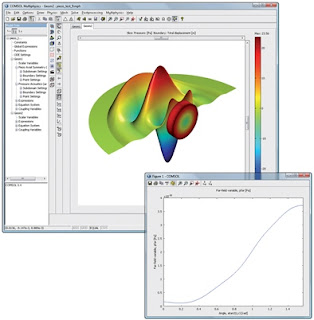
COMSOL Multiphysics 3.4 provides fully parallelized meshing for assemblies straight out of the box. A new boundary layer meshing feature in version 3.4 enables users to mesh thermal boundary layers, charged double-layers in AC/DC applications, or viscous boundary layers in fluid-flow applications more efficiently, with greater accuracy, and with less memory consumption than previously possible.
A major upgrade to COMSOL Multiphysics’s iterative methods pushes solver performance for fluid dynamics to new heights. For example, new, state-of-the-art Galerkin Least Squares (GLS) stabilization techniques now complement COMSOL’s iterative solvers, enabling engineers and scientists to compute large fluid flow problems with millions of degrees of freedom. A segregated solver with an easy-to-use interface, new in version 3.4, reduces memory consumption significantly when computing large problems, such as fluid-structure interaction (FSI) or wave propagation in thermally deformed structures. When compared to its predecessors, COMSOL Multiphysics 3.4 solves fluid-flow problems up to five times faster.
COMSOL Multiphysics 3.4 also offers users a new suite of postprocessing tools for computing geometric properties such as volume, area, center of gravity, and moment of inertia. Even simulation results can be presented in exciting new ways with version 3.4’s expanded palette of color scales.
Multiphase flow and free convection in the Chemical Engineering and Heat Transfer Modules
Users of the COMSOL Chemical Engineering and Heat Transfer Modules can now step up their simulations to include variable-density flow and free convection. Engineers will find these new capabilities particularly useful when solving coupled flow and conjugate heat transfer problems commonly encountered in electronic cooling and heat exchanger analyses. For applications such as microfluidics, multi-species convection, and reacting flows, COMSOL Multiphysics 3.4 has been enhanced with additional multiphysics modeling interfaces for turbulent and laminar flow with variable densities due to variations in composition.
The Chemical Engineering Module has been improved with a powerful modeling interface for the simulation of multiphase flow. With it, users can now simulate bubbly flows such as in scrubbers, aerators, bioreactors, and food-processing equipment effortlessly. Users can also easily set up mixture models for simulating emulsification, sedimentation, and other separation processes common in the chemical, pharmaceutical, and food-processing industries.
The Heat Transfer Module has been greatly enhanced by the introduction of boundary layer meshing and by improvements to COMSOL’s solver technology. Boundary layer meshing provides engineers and scientists with greater accuracy yet requires fewer elements for simulating electronic cooling, heat exchangers, and heat losses to solid structures in mechanical design. Also new in the Heat Transfer Module is the ability to model 3D surface-to-surface radiation using the memory-saving 2D axisymmetric modeling domain.
Parameter estimation in COMSOL Reaction Engineering Lab
Upgrades to the COMSOL Reaction Engineering Lab® include a powerful new interface for running nonlinear parameter estimations on multiple sets of experimental data. In addition, it is now possible to select which parameters to estimate and which parameters to keep constant in each estimation run. Outputs now display with confidence intervals and standard deviations.
SPICE import in the AC/DC Module and new lumped ports in the RF Module
Version 3.4 makes it easy to build and run COMSOL models as part of SPICE-based circuit simulations thanks to the AC/DC Module’s new SPICE user interface. Another exciting new feature for electronics, electrical components, geophysics, and electrochemistry applications is small-signal analysis for AC impedance studies. Users can also easily model electric motors and generators through a new interface supporting periodic boundary conditions and sector symmetry. Additionally, a new periodic boundary condition user interface has been introduced in the RF Module along with an improved interface for lumped port boundary conditions, which is ideal for wave propagation in transmission lines and circuit boards.
Fatigue analysis enhances the Structural Mechanics Module
The COMSOL Multiphysics Structural Mechanics Module now lets users predict high- and low-cycle fatigue damage. A suite of COMSOL Script functions calculate fatigue damage from inputs made up of loading data and deterministic, stochastic, or even nonproportional material fatigue data.
COMSOL Multiphysics 3.4 Highlights
Parallelized meshing, assembly, and solving on multicore and multiprocessor computers
Memory-efficient fluid flow solvers for chemical engineering, heat transfer, and microfluidics
Segregated solver minimizes memory consumption for large multiphysics problems
Improved postprocessing including geometric properties such as center of gravity
Easy modeling of electronics cooling and free convection with interfaces for variable-density flow
Boundary layer meshing for representing boundary layers in fluid flow, heat transfer, and electromagnetics
Bubbly flow interfaces for modeling of scrubbers, aerators, bioreactors, food processing equipment, and boiling
Mixture-model two-phase flow interfaces for simulation of emulsification, sedimentation and separation processes as well as fluidized beds
Nonlinear parameter estimation
Piezoacoustic multiphysics modeling of microphones, ultrasonic transducers and MEMS devices
Full-wave 3D RF analysis of printed circuit boards and transmission lines with lumped port boundary conditions
Fatigue analysis
 Software training,tutorials,download,torrent
Software training,tutorials,download,torrent